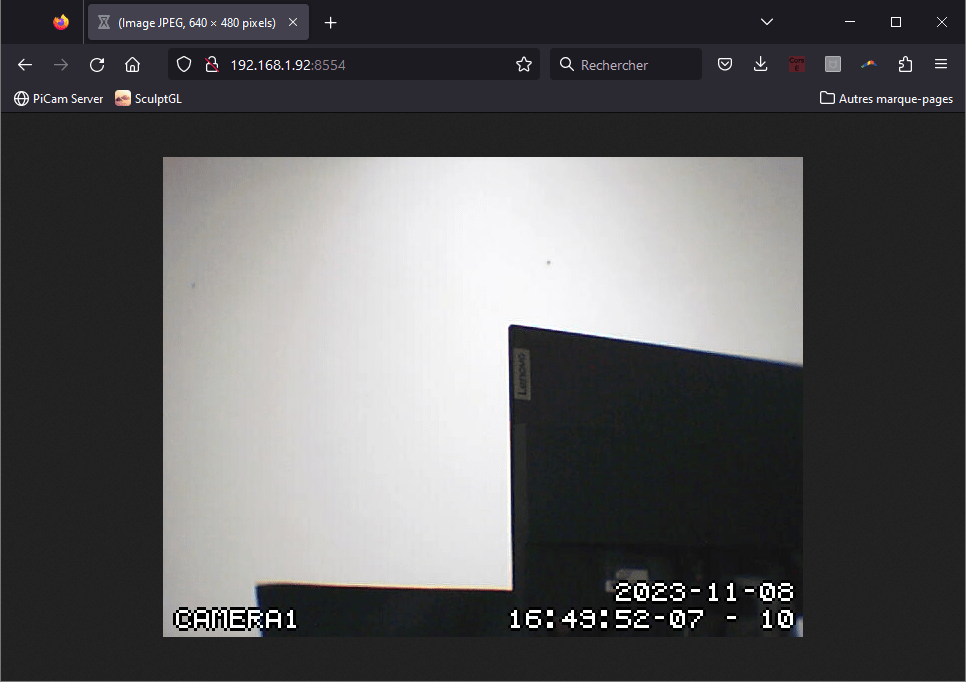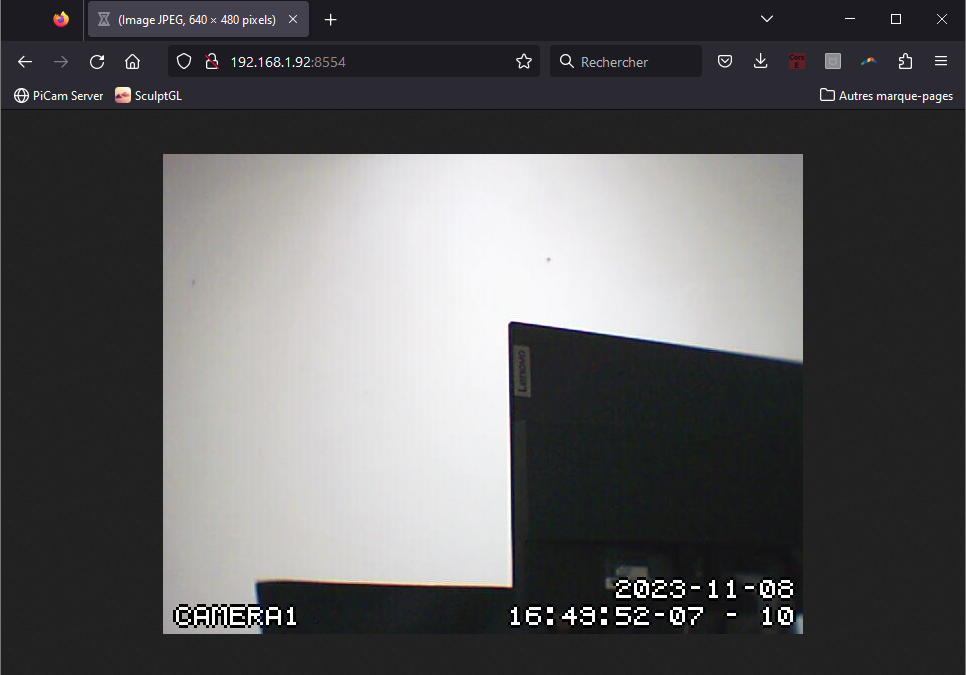Neste tutorial, veremos como configurar um fluxo de vídeo com o Motion a partir de um Raspberry Pi. Este tutorial é compatível com qualquer sistema Linux.
Hardware
- Raspberry Pi (ou outra máquina com Linux)
- Câmara USB ou câmara CSI
Descrição do movimento
O programa Motion foi desenvolvido como um sistema de vigilância. Permite observar várias câmaras, detetar movimentos em cada câmara e gravar imagens ou vídeos nesse momento.
Esta ferramenta permite
- transmitir vídeos para visualização remota
- detetar movimentos em cada câmara
- gravar imagens ou vídeos das câmaras
Instalação de movimento
Se este ainda não for o caso na sua versão do sistema operativo, pode instalar o Motion utilizando o seguinte comando.
sudo apt-get install motion
Verificar a instalação
motion --version
Se ocorrer um erro sobre a permissão de acesso ao ficheiro
Pode apagar o ficheiro e reiniciar
rm -r /var/log/motion
ou conceder direitos de acesso
sudo chmod -R 777 /var/log/motion sudo chmod -R 777 /var/lib/motion
ou criar outro ficheiro de registo e adicionar o seu caminho ao ficheiro motion.conf
sudo nano ~/.motion/motion.log
Configuração do movimento
Toda a configuração do movimento é efectuada no
sudo cp /etc/motion/motion.conf /etc/motion/motion.conf.bckp sudo nano /etc/motion/motion.conf
Os principais parâmetros incluem
- video_device para definir a câmara a utilizar
- parâmetros de captura (altura, largura, velocidade de fotogramas)
- texto a apresentar na imagem da câmara (text_left, text_right, etc.)
- parâmetros de deteção de movimento (limiar, event_gap, etc.)
- o ficheiro log_file para escrever os registos (predefinição:
- o diretório target_dir para guardar imagens e vídeos (predefinição;
- picture_output para captar imagens aquando da deteção
- video_output para gravar vídeos
N.B.: todos os parâmetros de configuração podem ser consultados no sítio Web oficial
Ir mais longe na configuração
Há um grande número de parâmetros no ficheiro motion.conf que lhe permitem adaptar a aquisição de imagens às suas necessidades
Se forem utilizadas várias câmaras, é possível definir um conjunto de parâmetros para cada câmara (/etc/motion/camera1.conf)
Iniciar o movimento a partir do terminal
sudo motion sudo motion -c ~/.motion/motion.conf #to use another configuration file sudo killall motion #to end the process
(utilizar ~/.motion/motion.conf por defeito, se existir, caso contrário /etc/motion/motion.conf)
Iniciar o Motion como um serviço
sudo service motion start sudo service motion status sudo service motion restart sudo service motion stop
N.B.: No ficheiro /etc/motion/motion.conf, deixe a opção daemon definida como OFF.
Criar um fluxo de vídeo com o Motion
Alterar as definições predefinidas em /etc/motion/motion.conf
webcontrol_port 8080 # define http port for camera web control http://<ip_server>:<webcontrol_port> webcontrol_localhost on # define if accessible only from the same machine stream_port 8081 # define http port for camera display http://<ip_server>:<stream_port> stream_localhost off stream_auth_method 0 stream_authentication <username>:<password>
N.B.: se ativar o webcontrol a partir do exterior da máquina, aconselhamos vivamente a ativar a autenticação no fluxo
Não se esqueça de reiniciar o serviço motion depois de fazer quaisquer alterações ao ficheiro motion.conf.
sudo service motion restart
Se introduzir o endereço IP da sua máquina Linux (aqui, 192.168.1.92), seguido do número da porta definido em stream_port, pode observar o fluxo de vídeo em movimento.

Se não estiver a utilizar movimento contínuo, pode gravar um vídeo sem esperar que seja detectado movimento (emulate_motion on, event_gap -1).
Sugestões: pode definir uma imagem de baixa qualidade para melhorar a largura de banda do fluxo (stream_quality 45) mas manter uma imagem de boa qualidade para a gravação de vídeo (video_quality 100).
Ficheiro motion.conf para streaming
/etc/motion/motion.conf (com webcontrol local e portas 8553 e 8554)
# Rename this distribution example file to motion.conf
#
# This config file was generated by motion 4.3.2
# Documentation: /usr/share/doc/motion/motion_guide.html
#
# This file contains only the basic configuration options to get a
# system working. There are many more options available. Please
# consult the documentation for the complete list of all options.
#
############################################################
# System control configuration parameters
############################################################
# Start in daemon (background) mode and release terminal.
daemon off
# Start in Setup-Mode, daemon disabled.
setup_mode off
# File to store the process ID.
; pid_file value
# File to write logs messages into. If not defined stderr and syslog is used.
log_file /var/log/motion/motion.log
# Level of log messages [1..9] (EMG, ALR, CRT, ERR, WRN, NTC, INF, DBG, ALL).
log_level 6
# Target directory for pictures, snapshots and movies
target_dir /var/lib/motion
# Video device (e.g. /dev/video0) to be used for capturing.
videodevice /dev/video0
# Parameters to control video device. See motion_guide.html
; vid_control_params value
# The full URL of the network camera stream.
; netcam_url value
# Name of mmal camera (e.g. vc.ril.camera for pi camera).
; mmalcam_name value
# Camera control parameters (see raspivid/raspistill tool documentation)
; mmalcam_control_params value
############################################################
# Image Processing configuration parameters
############################################################
# Image width in pixels.
width 640
# Image height in pixels.
height 480
# Maximum number of frames to be captured per second.
framerate 10
# Text to be overlayed in the lower left corner of images
text_left CAMERA1
# Text to be overlayed in the lower right corner of images.
text_right %Y-%m-%d\n%T-%q - %{fps}
text_scale 3
############################################################
# Motion detection configuration parameters
############################################################
# Always save pictures and movies even if there was no motion.
emulate_motion off
# Threshold for number of changed pixels that triggers motion.
threshold 1500
# Noise threshold for the motion detection.
; noise_level 32
# Despeckle the image using (E/e)rode or (D/d)ilate or (l)abel.
despeckle_filter EedDl
# Number of images that must contain motion to trigger an event.
minimum_motion_frames 1
# Gap in seconds of no motion detected that triggers the end of an event.
event_gap 60
# The number of pre-captured (buffered) pictures from before motion.
pre_capture 3
# Number of frames to capture after motion is no longer detected.
post_capture 0
############################################################
# Script execution configuration parameters
############################################################
# Command to be executed when an event starts.
; on_event_start value
# Command to be executed when an event ends.
; on_event_end value
# Command to be executed when a movie file is closed.
; on_movie_end value
############################################################
# Picture output configuration parameters
############################################################
# Output pictures when motion is detected
picture_output off
# File name(without extension) for pictures relative to target directory
picture_filename %Y%m%d%H%M%S-%q
############################################################
# Movie output configuration parameters
############################################################
# Create movies of motion events.
movie_output on
# Maximum length of movie in seconds.
movie_max_time 60
# The encoding quality of the movie. (0=use bitrate. 1=worst quality, 100=best)
movie_quality 100
# Container/Codec to used for the movie. See motion_guide.html
movie_codec mkv
# File name(without extension) for movies relative to target directory
movie_filename %t-%v-%Y%m%d%H%M%S
############################################################
# Webcontrol configuration parameters
############################################################
# Port number used for the webcontrol.
webcontrol_port 8553
# Restrict webcontrol connections to the localhost.
webcontrol_localhost on
# Type of configuration options to allow via the webcontrol.
webcontrol_parms 0
############################################################
# Live stream configuration parameters
############################################################
# The port number for the live stream.
stream_port 8554
# Restrict stream connections to the localhost.
stream_localhost off
stream_quality 100
##############################################################
# Camera config files - One for each camera.
##############################################################
; camera /usr/etc/motion/camera1.conf
; camera /usr/etc/motion/camera2.conf
; camera /usr/etc/motion/camera3.conf
; camera /usr/etc/motion/camera4.conf
##############################################################
# Directory to read '.conf' files for cameras.
##############################################################
; camera_dir /usr/etc/motion/conf.d
Aplicações
- Criar um sistema de videovigilância
- Utilização do MotionEye OS
